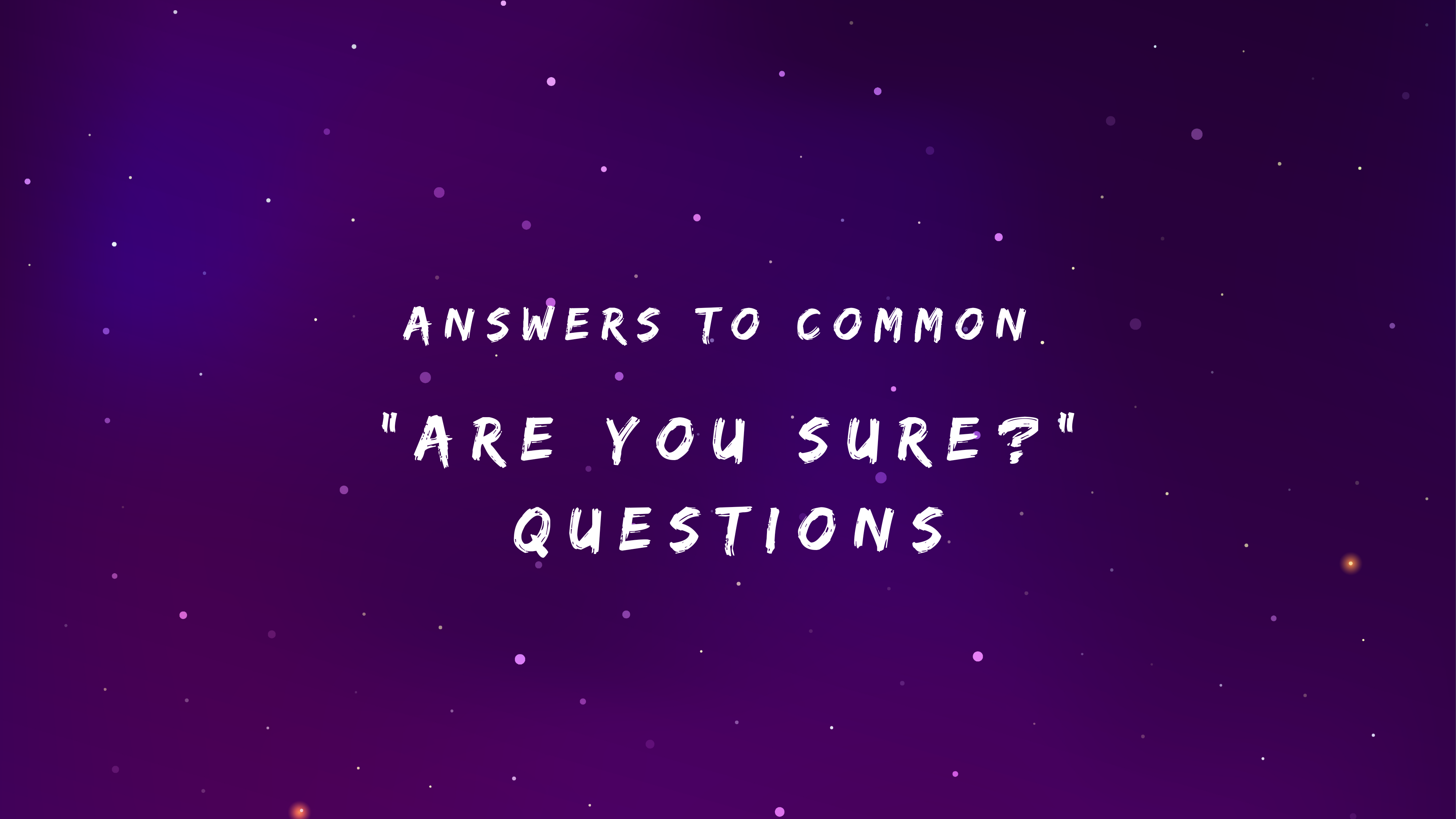We’ve all been there: you’re deciding, and someone asks, “Are you sure?” It can throw you off your game, but it’s also a chance to reflect and reaffirm your choices. Understanding why people ask this and how to respond can help you communicate more confidently and effectively.
Understanding the Context of “Are You Sure?”
- Social and Professional Scenarios
“Are you sure?” isn’t just a phrase; it’s a gateway into the other person’s concerns or doubts. In social settings, it might reflect a friend’s hesitation about your plans. Professionally, it could signal a manager’s need for clarity before proceeding with a project. Understanding the context is crucial for crafting a suitable response.
- Emotional and Psychological Implications
This question can trigger insecurity or defensiveness. Psychologically, it often reflects the questioner’s uncertainties or need for reassurance. Recognizing these underlying factors can help you address the question more empathetically.

150+ Answers to “Are You Sure?”
Affirmative Confirmation
- Yes, I’m sure about this.
- No doubt in my mind.
- I’m confident this is correct.
- Without a shadow of a doubt, I’m sure.
- Yes, I’ve double-checked, and everything’s fine.
- No question about it—I’m certain.
- Sure, I’ve reviewed it thoroughly.
- I’m sure, 100% certain.
- Yes, everything’s been confirmed.
- I’m sure, and I stand by it.
Conditional Confirmation
- I’m sure, but let’s ensure all the details are correct.
- Yes, if we follow through with the plan as discussed.
- I’m confident, provided that all the conditions are met.
- I’m certain, assuming nothing changes.
- Yes, but let’s confirm this again just to be safe.
- I’m sure, as long as we keep to the agreed steps.
- I’m confident that you’re also on board.
- Yes, but let’s ensure there are no overlooked details.
- I’m sure, but let’s cross-check it again.
- I’m sure that everything will stay as planned.
Hesitant or Unsure
- I’m not entirely sure; maybe we should review it again.
- I have some reservations, but it should be fine.
- I’m a bit unsure; let’s check it once more.
- I’m not completely confident—let’s discuss this further.
- I’m hesitant; it might be worth a second look.
- I have doubts; we should verify this.
- I’m not certain; let’s get more clarity.
- I’m unsure; could we review the details again?
- I have some concerns; let’s confirm before proceeding.
- I’m not entirely sure, so let’s take another look.
Seeking Clarification
- Can you explain what you mean by that?
- Please provide more detail on this.
- What exactly are you referring to here?
- I’m not clear on what you’re asking—could you clarify?
- Can you give me some more context about this?
- I’m not entirely sure what you’re asking; can you elaborate?
- Could you specify which part you’re concerned about?
- I need a bit more information to be sure—can you help?
- What details should I be focusing on to understand this better?
- Please clarify the main points here for me.
Requesting More Information
- Could you provide more details about this situation?
- I’d like to know more before confirming—can you share additional information?
- Can you give me some background on why you’re asking?
- I need a bit more context—what’s the full story?
- Can you explain what led to this question?
- I’d appreciate more specifics to ensure I’m making the right decision.
- Can you outline the details or concerns you have?
- What more can you tell me to help me understand better?
- Can you provide further information to help clarify things?
- I’d like to know more about the factors involved—can you elaborate?
Reassuring
- Don’t worry, everything’s been checked and it’s all good.
- I’ve got this under control—there’s nothing to worry about.
- Everything is fine; you can trust that this is accurate.
- I’ve reviewed everything, and it’s all set.
- Rest assured, everything is in order.
- There’s no need to worry; I’ve confirmed it.
- I’ve made sure everything is correct, so you’re covered.
- Everything has been verified, so we’re on track.
- It’s all been checked thoroughly—no need to stress.
- I understand your concern, but everything is handled.
Deflecting or Avoiding
- Let’s not overthink it; it’s not a big deal.
- I wouldn’t worry too much about it right now.
- It’s not worth stressing over; let’s move on.
- I think we’ve covered enough; let’s focus on something else.
- It’s probably not as important as it seems; let’s keep going.
- I’d rather not dwell on this; we have other things to address.
- It’s not critical—let’s just proceed as planned.
- Let’s set this aside for now and tackle it later if needed.
- It’s fine; there’s no need to make a big fuss about it.
- Let’s keep things simple; it’ll work out.
Reevaluation
- Let me double-check and get back to you with an update.
- I’ll review the details again to make sure everything’s correct.
- Give me a moment to re-evaluate this, and I’ll confirm soon.
- I need to take another look to be sure.
- Let me review it again, and I’ll let you know.
- I’ll reassess the situation and follow up with you shortly.
- Let me check again to ensure everything is as it should be.
- I’ll review everything again and get back to you with confirmation.
- I want to be sure, so I’ll take another look and update you.
- I’ll take some time to re-evaluate and confirm the details.
Empathetic
- I get why you’re asking; it’s important to be sure. Yes, I’m confident.
- I understand your concern—yes, I’ve checked it thoroughly.
- I see why you’re uncertain; let me assure you, it’s all good.
- I know this is important, and I’m sure about it.
- I appreciate your caution; I’ve confirmed everything is correct.
- It’s okay to question this; I’m confident in my answer.
- I understand your hesitation, but I’m sure this is right.
- I get where you’re coming from; I’m sure about it.
- I see why you’d ask that—everything is checked and verified.
- I’m sure your concern is valid, and I’ve ensured everything’s right.
Confirming with Authority
- According to the guidelines, this is the right approach.
- Based on expert recommendations, yes, I’m sure.
- The official policy confirms that this is correct.
- Our standard procedures back this up, so I’m confident.
- This aligns with what we’ve been advised to do.
- The data from our trusted sources supports this.
- Industry standards confirm this, so it’s accurate.
- According to our protocols, yes, this is the right choice.
- The experts have reviewed this, and it’s all in order.
- I’ve consulted with the specialists, and they agree this is correct.
Historical Confidence
- Based on our experience with similar situations, yes, I’m sure.
- Historically, this approach has always worked well.
- From what we’ve seen, this is the right decision.
- Our previous outcomes support that this is correct.
- Experience shows that this is the best course of action.
- We’ve handled similar cases successfully before, so I’m confident.
- Historical data backs up this choice, so I’m sure.
- Our track record indicates that this is accurate.
- Looking at our past results, this aligns perfectly.
- Previous instances have confirmed this as the correct path.
Emotional Assurance
- I understand this is important to you; I’m certain everything is fine.
- I know this is a big deal, and I want to reassure you that it’s all okay.
- Trust me, I’ve handled this, and everything’s in order.
- I can see why you’re worried; I’m confident everything will turn out well.
- I understand your concerns but rest assured they have been resolved.
- I know it matters greatly, and I’m certain everything is right.
- I want you to feel comfortable; everything has been thoroughly checked.
- I understand how you feel, and I’m sure everything’s fine.
- I get your anxiety, but I assure you that everything is under control.
- I can sense your worry, but I am confident in the accuracy and outcome.
Pragmatic
- Given the current situation, this is the best decision we can make.
- It makes the most sense to go with this approach right now.
- Considering all factors, this is the most practical choice.
- This solution aligns well with our immediate needs.
- From a practical standpoint, this is the right call.
- Based on what we have, this is the most sensible option.
- This approach is the most straightforward given the circumstances.
- In practical terms, this is the most effective solution.
- Given the resources and time, this is the most feasible option.
- This is the logical choice based on what we know.
Overruled Doubts
- I’ve weighed all the concerns and am confident this is correct.
- Despite any lingering doubts, I’m certain this is the right decision.
- I’ve addressed all potential issues and still stand by this choice.
- Any reservations have been considered, and I’m sure this is accurate.
- Even with some uncertainties, the evidence supports this.
- I’ve reviewed all possible doubts and remain confident in this answer.
- All the concerns have been reviewed; this is the best course of action.
- I understand there might be doubts, but I’m still sure this is right.
- Despite some lingering questions, I’m confident this is correct.
- I’ve considered all my doubts and am certain this is the right decision.
Acknowledging Risks
- Yes, I’m sure, but remember that some risks are involved.
- I’m confident in this decision, though there are a few potential risks.
- Everything looks good, but we should be aware of possible risks.
- I’m sure, but let’s not ignore the potential challenges.
- This is the best choice, despite some risks to consider.
- This is right, but let’s monitor any potential issues.
- I’m confident but be prepared for some possible complications.
- There are risks, but this remains the most viable option.
- I’m sure about this, though we should be cautious of the associated risks.
- While I’m confident in this decision, I must be aware of any risks.
Common Situations and Responses
In Personal Relationships
- Confirming Decisions with Loved Ones
When making personal decisions, such as moving to a new city or changing careers, loved ones might ask, “Are you sure?” to show concern. A thoughtful response involves explaining your reasoning and demonstrating that you’ve considered the implications thoroughly.
- Navigating Doubts and Reassurances
Sometimes, reassurance is needed. If your decision involves a significant life change, it’s important to acknowledge the concerns and provide a clear rationale. It’s about balancing your conviction with sensitivity to their feelings.
In the Workplace
- Addressing Mistakes or Errors
The question might arise in professional environments when discussing potential errors or oversight. It’s vital to address the issue directly, provide evidence of your decision-making process, and show that you’re taking steps to correct any mistakes.
- Handling Project Confirmation
When managing projects, “Are you sure?” might come up when finalizing details or deadlines. Respond with data, timelines, and a clear plan to reassure stakeholders and colleagues of your confidence and preparation.
In Customer Service
- Ensuring Satisfaction
Customer service often involves confirming details about orders or services. A clear and positive response can enhance customer trust. If a customer asks, “Are you sure?” ensure that you provide accurate and reassuring information.
- Dealing with Complaints and Feedback
When handling complaints, the question may surface in discussions about resolutions. Address the concern with empathy, validate their feedback, and provide a comprehensive plan for addressing the issue.
How to Effectively Answer “Are You Sure?”
- Providing Evidence and Justification
When faced with this question, backing up your response with evidence can bolster your credibility. Whether it’s data, research, or personal experience, showing that you’ve made an informed decision helps reinforce your confidence.
- Using Confidence to Build Trust
Confidently presenting your answer can help build trust and persuade others of your commitment. Confidence doesn’t mean arrogance; it’s about presenting your position firmly while being open to discussion.
- Balancing Assertiveness and Humility
Effective communication involves balancing assertiveness with humility. While it’s important to be confident, acknowledging that you are open to feedback and willing to reconsider can make your responses more persuasive and empathetic.
Strategies for Handling Doubts
- Verifying Facts and Information
When in doubt, double-check your facts. Thorough verification boosts your confidence and ensures that your responses are accurate and reliable.
- Clarifying Uncertainties
If the question stems from a misunderstanding, clarifying your point can help. Take the time to explain your reasoning and address any misconceptions.
- Seeking Feedback and Second Opinions
Don’t hesitate to seek feedback from others. Consulting with colleagues or friends can provide additional perspectives and reinforce decision-making.
Examples of Effective Responses
- Positive Confirmation Techniques
For a positive confirmation, you might say, “Yes, I’m sure because I’ve reviewed all the details and considered the alternatives. Here’s why this is the best choice.” This reassures others of your thoroughness.
- Neutral Responses to Avoid Conflict
Respond neutrally if you want to avoid conflict: “I understand your concerns. I’ve considered this thoroughly and am confident in my decision, but I’m happy to discuss it further if needed.”
- Handling Challenging Situations
In challenging situations, address the concern directly: “I see why you’re asking. Here’s my reasoning, and I’m open to discussing any additional concerns you might have.”
Conclusion
In conclusion, mastering the art of responding to “Are you sure?” questions can significantly enhance your communication skills and confidence in various situations. With over 150 responses provided in this guide, you now have a versatile toolkit to navigate these often tricky conversations. Whether you’re addressing doubts in personal or professional settings, these answers can help you respond with clarity and assurance. For more ways to refine your conversational skills,
check out our guide on:
How to Respond to “Good to See You”: 150+ Responses
FAQs
Q. What should I do if I’m unsure about a decision?
If you’re unsure, take the time to gather more information and consult with trusted individuals. It’s okay to step back and reassess before finalizing your decision.
Q. How can I reassure someone who questions my choices?
Provide clear explanations and evidence for your choices. Acknowledge their concerns and show that you’ve thoroughly considered the options.
Q. What are some strategies for gaining confidence in my answers?
Gain confidence by preparing thoroughly, seeking feedback, and reflecting on past successes. Practice presenting your answers to build self-assurance.
Q. How can I handle repeated “Are You Sure?” questions?
Address each question with patience and clarity. Provide additional information or explanations if needed, reaffirm your position, and remain open to discussion.
Q. Is it okay to admit uncertainty in professional settings?
Yes, admitting uncertainty can be a sign of honesty and professionalism. It’s important to be transparent and seek additional input to make informed decisions.











Temp Mail This is my first time pay a quick visit at here and i am really happy to read everthing at one place
Vitazen Keto I’m often to blogging and i really appreciate your content. The article has actually peaks my interest. I’m going to bookmark your web site and maintain checking for brand spanking new information.
Your blog is a constant source of inspiration for me. Your passion for your subject matter is palpable, and it’s clear that you pour your heart and soul into every post. Keep up the incredible work!
I am not sure where youre getting your info but good topic I needs to spend some time learning much more or understanding more Thanks for magnificent info I was looking for this information for my mission
Hi my family member I want to say that this post is awesome nice written and come with approximately all significant infos I would like to peer extra posts like this
Профессиональный сервисный центр по ремонту бытовой техники с выездом на дом.
Мы предлагаем: ремонт крупногабаритной техники в москве
Наши мастера оперативно устранят неисправности вашего устройства в сервисе или с выездом на дом!